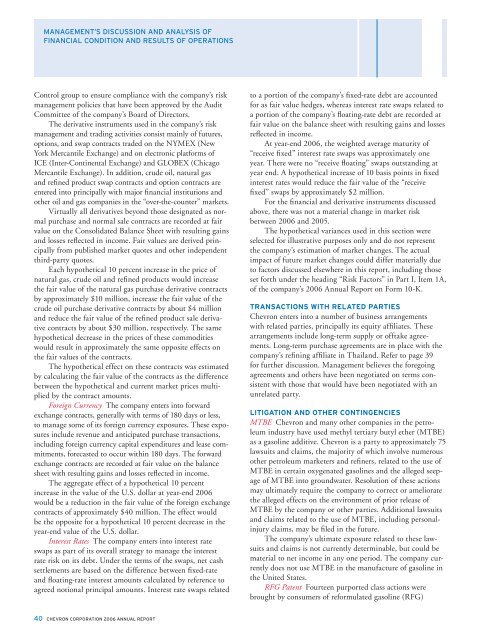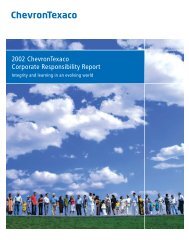Chevron 2006 Annual Report
Chevron 2006 Annual Report
Chevron 2006 Annual Report
You also want an ePaper? Increase the reach of your titles
YUMPU automatically turns print PDFs into web optimized ePapers that Google loves.
MANAGEMENT’S DISCUSSION AND ANALYSIS OF<br />
FINANCIAL CONDITION AND RESULTS OF OPERATIONS<br />
Control group to ensure compliance with the company’s risk<br />
management policies that have been approved by the Audit<br />
Committee of the company’s Board of Directors.<br />
The derivative instruments used in the company’s risk<br />
management and trading activities consist mainly of futures,<br />
options, and swap contracts traded on the NYMEX (New<br />
York Mercantile Exchange) and on electronic platforms of<br />
ICE (Inter-Continental Exchange) and GLOBEX (Chicago<br />
Mercantile Exchange). In addition, crude oil, natural gas<br />
and refined product swap contracts and option contracts are<br />
entered into principally with major financial institutions and<br />
other oil and gas companies in the “over-the-counter” markets.<br />
Virtually all derivatives beyond those designated as normal<br />
purchase and normal sale contracts are recorded at fair<br />
value on the Consolidated Balance Sheet with resulting gains<br />
and losses reflected in income. Fair values are derived principally<br />
from published market quotes and other independent<br />
third-party quotes.<br />
Each hypothetical 10 percent increase in the price of<br />
natural gas, crude oil and refi ned products would increase<br />
the fair value of the natural gas purchase derivative contracts<br />
by approximately $10 million, increase the fair value of the<br />
crude oil purchase derivative contracts by about $4 million<br />
and reduce the fair value of the refined product sale derivative<br />
contracts by about $30 million, respectively. The same<br />
hypothetical decrease in the prices of these commodities<br />
would result in approximately the same opposite effects on<br />
the fair values of the contracts.<br />
The hypothetical effect on these contracts was estimated<br />
by calculating the fair value of the contracts as the difference<br />
between the hypothetical and current market prices multiplied<br />
by the contract amounts.<br />
Foreign Currency The company enters into forward<br />
exchange contracts, generally with terms of 180 days or less,<br />
to manage some of its foreign currency exposures. These exposures<br />
include revenue and anticipated purchase transactions,<br />
including foreign currency capital expenditures and lease commitments,<br />
forecasted to occur within 180 days. The forward<br />
exchange contracts are recorded at fair value on the balance<br />
sheet with resulting gains and losses reflected in income.<br />
The aggregate effect of a hypothetical 10 percent<br />
increase in the value of the U.S. dollar at year-end <strong>2006</strong><br />
would be a reduction in the fair value of the foreign exchange<br />
contracts of approximately $40 million. The effect would<br />
be the opposite for a hypothetical 10 percent decrease in the<br />
year-end value of the U.S. dollar.<br />
Interest Rates The company enters into interest rate<br />
swaps as part of its overall strategy to manage the interest<br />
rate risk on its debt. Under the terms of the swaps, net cash<br />
settlements are based on the difference between fi xed-rate<br />
and floating-rate interest amounts calculated by reference to<br />
agreed notional principal amounts. Interest rate swaps related<br />
to a portion of the company’s fi xed-rate debt are accounted<br />
for as fair value hedges, whereas interest rate swaps related to<br />
a portion of the company’s floating-rate debt are recorded at<br />
fair value on the balance sheet with resulting gains and losses<br />
reflected in income.<br />
At year-end <strong>2006</strong>, the weighted average maturity of<br />
“receive fi xed” interest rate swaps was approximately one<br />
year. There were no “receive floating” swaps outstanding at<br />
year end. A hypothetical increase of 10 basis points in fi xed<br />
interest rates would reduce the fair value of the “receive<br />
fi xed” swaps by approximately $2 million.<br />
For the financial and derivative instruments discussed<br />
above, there was not a material change in market risk<br />
between <strong>2006</strong> and 2005.<br />
The hypothetical variances used in this section were<br />
selected for illustrative purposes only and do not represent<br />
the company’s estimation of market changes. The actual<br />
impact of future market changes could differ materially due<br />
to factors discussed elsewhere in this report, including those<br />
set forth under the heading “Risk Factors” in Part I, Item 1A,<br />
of the company’s <strong>2006</strong> <strong>Annual</strong> <strong>Report</strong> on Form 10-K.<br />
TRANSACTIONS WITH RELATED PARTIES<br />
<strong>Chevron</strong> enters into a number of business arrangements<br />
with related parties, principally its equity affi liates. These<br />
arrangements include long-term supply or offtake agreements.<br />
Long-term purchase agreements are in place with the<br />
company’s refining affi liate in Thailand. Refer to page 39<br />
for further discussion. Management believes the foregoing<br />
agreements and others have been negotiated on terms consistent<br />
with those that would have been negotiated with an<br />
unrelated party.<br />
LITIGATION AND OTHER CONTINGENCIES<br />
MTBE <strong>Chevron</strong> and many other companies in the petroleum<br />
industry have used methyl tertiary butyl ether (MTBE)<br />
as a gasoline additive. <strong>Chevron</strong> is a party to approximately 75<br />
lawsuits and claims, the majority of which involve numerous<br />
other petroleum marketers and refiners, related to the use of<br />
MTBE in certain oxygenated gasolines and the alleged seepage<br />
of MTBE into groundwater. Resolution of these actions<br />
may ultimately require the company to correct or ameliorate<br />
the alleged effects on the environment of prior release of<br />
MTBE by the company or other parties. Additional lawsuits<br />
and claims related to the use of MTBE, including personalinjury<br />
claims, may be fi led in the future.<br />
The company’s ultimate exposure related to these lawsuits<br />
and claims is not currently determinable, but could be<br />
material to net income in any one period. The company currently<br />
does not use MTBE in the manufacture of gasoline in<br />
the United States.<br />
RFG Patent Fourteen purported class actions were<br />
brought by consumers of reformulated gasoline (RFG)<br />
40 CHEVRON CORPORATION <strong>2006</strong> ANNUAL REPORT

















